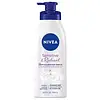Nivea Radiant & Beauty Even Glow Lotion Versus Nivea Sensitive and Radiant Body Lotion - Dry Sensitive Skin
What's inside
What's inside
 Key Ingredients
Key Ingredients

 Benefits
Benefits

 Concerns
Concerns

 Ingredients Side-by-side
Ingredients Side-by-side

Water
Skin ConditioningGlycerin
HumectantC12-15 Alkyl Benzoate
AntimicrobialAlcohol Denat.
AntimicrobialButyl Methoxydibenzoylmethane
UV AbsorberCetyl Alcohol
EmollientDimethicone
EmollientOctocrylene
UV AbsorberStearic Acid
CleansingCetyl Palmitate
EmollientGlyceryl Stearate
EmollientPhenoxyethanol
PreservativeTapioca Starch
Sodium Hydroxide
BufferingCarbomer
Emulsion StabilisingMethylparaben
PreservativeTrisodium EDTA
4-Butylresorcinol
AntioxidantEthylparaben
PreservativeDiethylhexyl Syringylidenemalonate
Skin ProtectingMyristic Acid
CleansingArachidic Acid
CleansingCaprylic/Capric Triglyceride
MaskingOleic Acid
EmollientLactic Acid
BufferingSodium Ascorbyl Phosphate
AntioxidantHydrolyzed Pearl
Skin ConditioningMaltodextrin
AbsorbentCitrus Limon Juice
Skin ConditioningPEG-40 Hydrogenated Castor Oil
EmulsifyingTrideceth-9
EmulsifyingDecylene Glycol
Skin ConditioningAscorbic Acid
Antioxidant1,2-Hexanediol
Skin ConditioningParfum
MaskingWater, Glycerin, C12-15 Alkyl Benzoate, Alcohol Denat., Butyl Methoxydibenzoylmethane, Cetyl Alcohol, Dimethicone, Octocrylene, Stearic Acid, Cetyl Palmitate, Glyceryl Stearate, Phenoxyethanol, Tapioca Starch, Sodium Hydroxide, Carbomer, Methylparaben, Trisodium EDTA, 4-Butylresorcinol, Ethylparaben, Diethylhexyl Syringylidenemalonate, Myristic Acid, Arachidic Acid, Caprylic/Capric Triglyceride, Oleic Acid, Lactic Acid, Sodium Ascorbyl Phosphate, Hydrolyzed Pearl, Maltodextrin, Citrus Limon Juice, PEG-40 Hydrogenated Castor Oil, Trideceth-9, Decylene Glycol, Ascorbic Acid, 1,2-Hexanediol, Parfum
Water
Skin ConditioningGlycerin
HumectantCetearyl Alcohol
EmollientC15-19 Alkane
SolventGlyceryl Stearate Se
EmulsifyingIsopropyl Palmitate
EmollientGlyceryl Stearate
EmollientPetrolatum
EmollientPanthenol
Skin ConditioningHelianthus Annuus Seed Oil
EmollientPrunus Amygdalus Dulcis Oil
Skin ConditioningGlycine Soja Oil
EmollientHydrolyzed Pearl
Skin ConditioningTocopheryl Acetate
AntioxidantHydrogenated Coco-Glycerides
EmollientSodium Cetearyl Sulfate
CleansingPhenoxyethanol
PreservativeEthylhexylglycerin
Skin ConditioningPantolactone
HumectantCarbomer
Emulsion StabilisingSodium Hydroxide
BufferingCitric Acid
BufferingSodium Citrate
BufferingWater, Glycerin, Cetearyl Alcohol, C15-19 Alkane, Glyceryl Stearate Se, Isopropyl Palmitate, Glyceryl Stearate, Petrolatum, Panthenol, Helianthus Annuus Seed Oil, Prunus Amygdalus Dulcis Oil, Glycine Soja Oil, Hydrolyzed Pearl, Tocopheryl Acetate, Hydrogenated Coco-Glycerides, Sodium Cetearyl Sulfate, Phenoxyethanol, Ethylhexylglycerin, Pantolactone, Carbomer, Sodium Hydroxide, Citric Acid, Sodium Citrate
Ingredients Explained
These ingredients are found in both products.
Ingredients higher up in an ingredient list are typically present in a larger amount.
Carbomer is a polymer of acrylic acid. Its main role is to create a gel consistency.
A high amount of carbomer can cause pilling or balling up of products. Don't worry, most products contain 1% or less of carbomer.
Glycerin is already naturally found in your skin. It helps moisturize and protect your skin.
A study from 2016 found glycerin to be more effective as a humectant than AHAs and hyaluronic acid.
As a humectant, it helps the skin stay hydrated by pulling moisture to your skin. The low molecular weight of glycerin allows it to pull moisture into the deeper layers of your skin.
Hydrated skin improves your skin barrier; Your skin barrier helps protect against irritants and bacteria.
Glycerin has also been found to have antimicrobial and antiviral properties. Due to these properties, glycerin is often used in wound and burn treatments.
In cosmetics, glycerin is usually derived from plants such as soybean or palm. However, it can also be sourced from animals, such as tallow or animal fat.
This ingredient is organic, colorless, odorless, and non-toxic.
Glycerin is the name for this ingredient in American English. British English uses Glycerol/Glycerine.
Learn more about GlycerinGlyceryl Stearate is a mix of glycerin and stearic acid.
It is used to stabilize the mixing of water and oil ingredients. By preventing these ingredients from separating, it can help elongate shelf life. It can also help thicken the product's texture.
As an emollient, it helps soften skin and supports barrier-replenishing ingredients.
In cosmetics, Glyceryl Stearate is often made from vegetable oils or synthetically produced.
This ingredient may not be fungal-acne safe
Fun fact: The human body also creates Glyceryl Stearate naturally.
Learn more about Glyceryl StearateWe don't have a description for Hydrolyzed Pearl yet.
Phenoxyethanol is a preservative that has germicide, antimicrobial, and aromatic properties. Studies show that phenoxyethanol can prevent microbial growth. By itself, it has a scent that is similar to that of a rose.
It's often used in formulations along with Caprylyl Glycol to preserve the shelf life of products.
Sodium Hydroxide is also known as lye or caustic soda. It is used to adjust the pH of products; many ingredients require a specific pH to be effective.
In small amounts, sodium hydroxide is considered safe to use. However, large amounts may cause chemical burns due to its high alkaline.
Your skin has a natural pH and acid mantle. This acid mantle helps prevent harmful bacteria from breaking through. The acid mantle also helps keep your skin hydrated.
"Alkaline" refers to a high pH level. A low pH level would be considered acidic.
Learn more about Sodium HydroxideWater. It's the most common cosmetic ingredient of all. You'll usually see it at the top of ingredient lists, meaning that it makes up the largest part of the product.
So why is it so popular? Water most often acts as a solvent - this means that it helps dissolve other ingredients into the formulation.
You'll also recognize water as that liquid we all need to stay alive. If you see this, drink a glass of water. Stay hydrated!
Learn more about Water